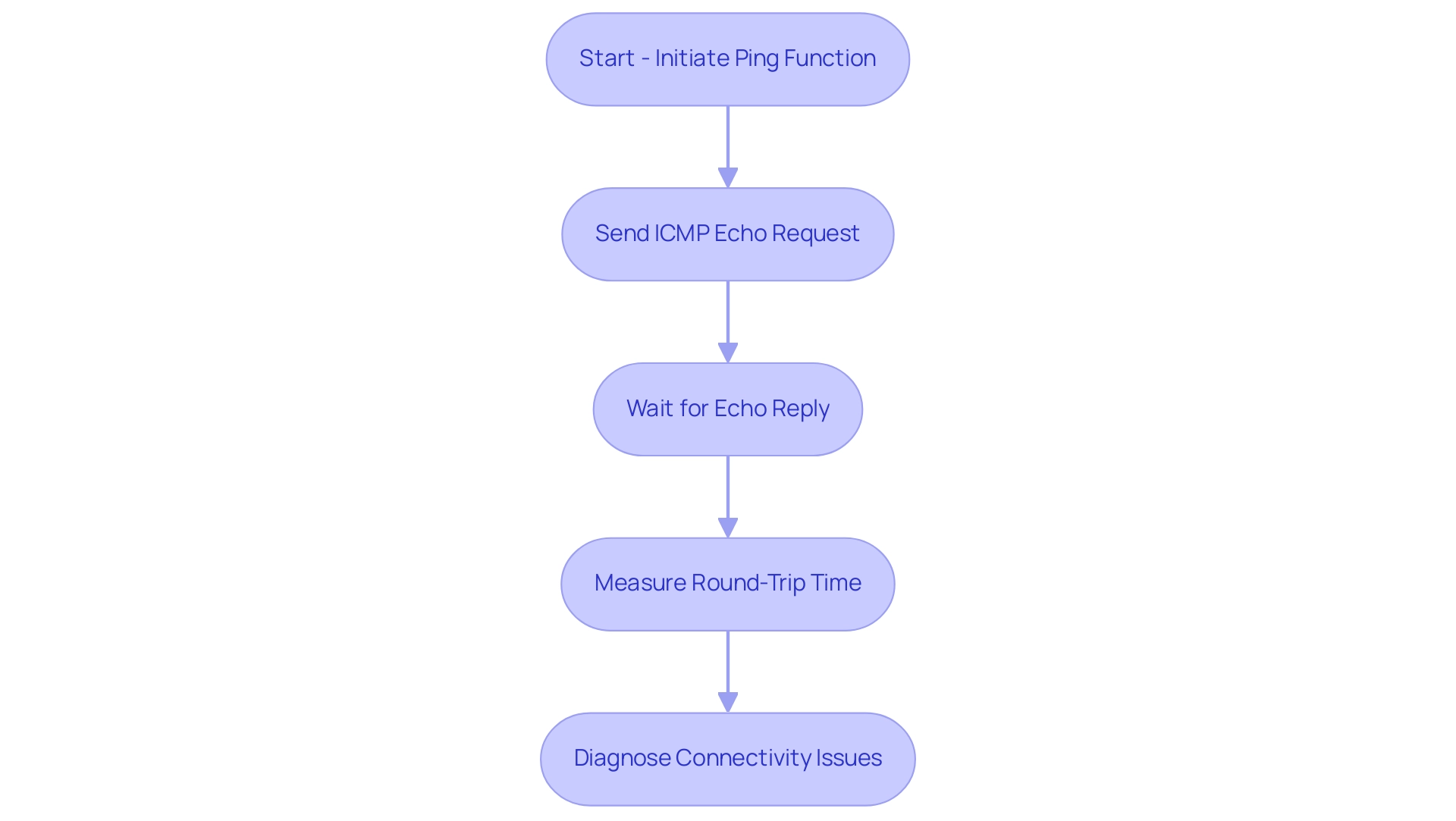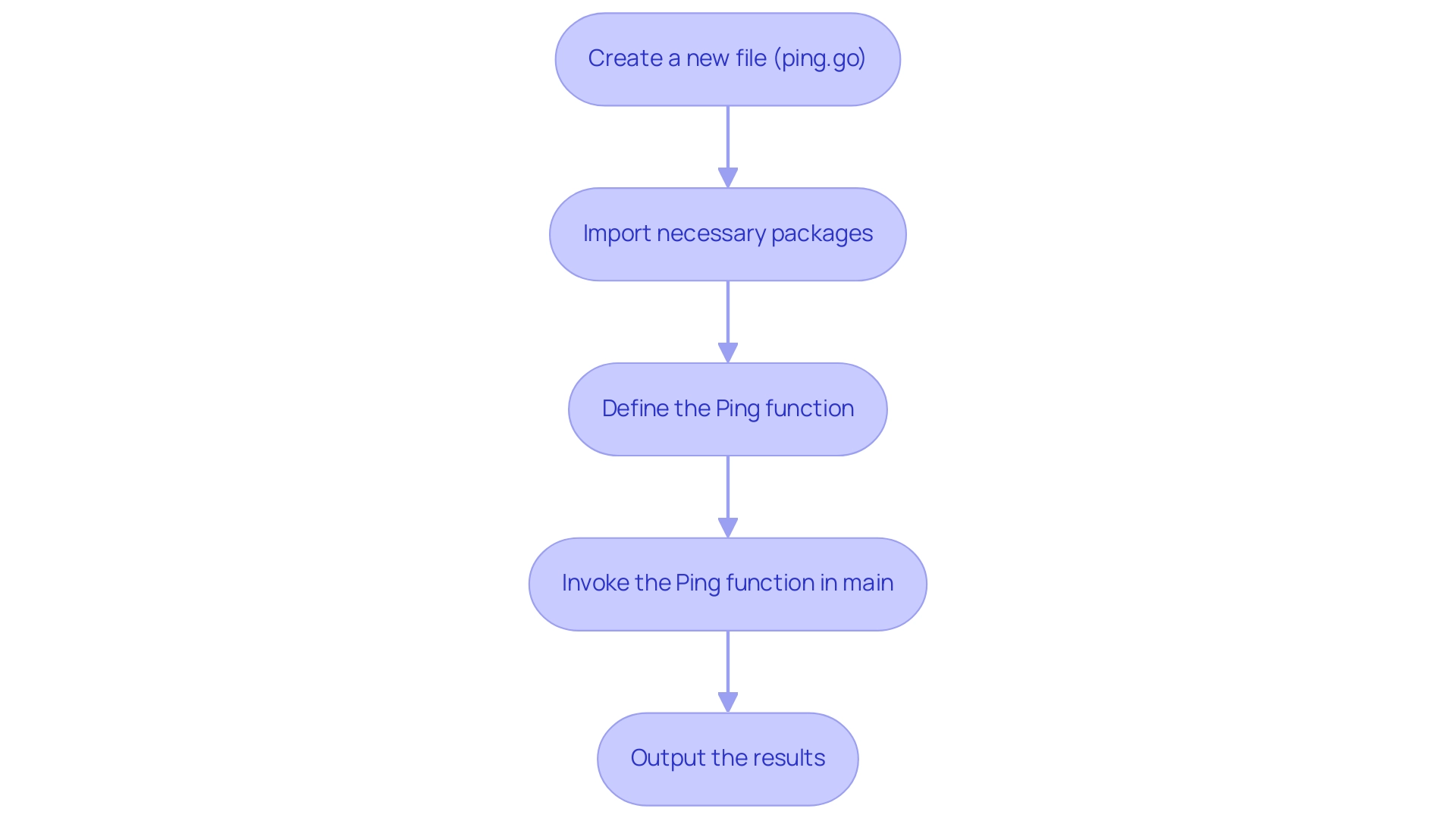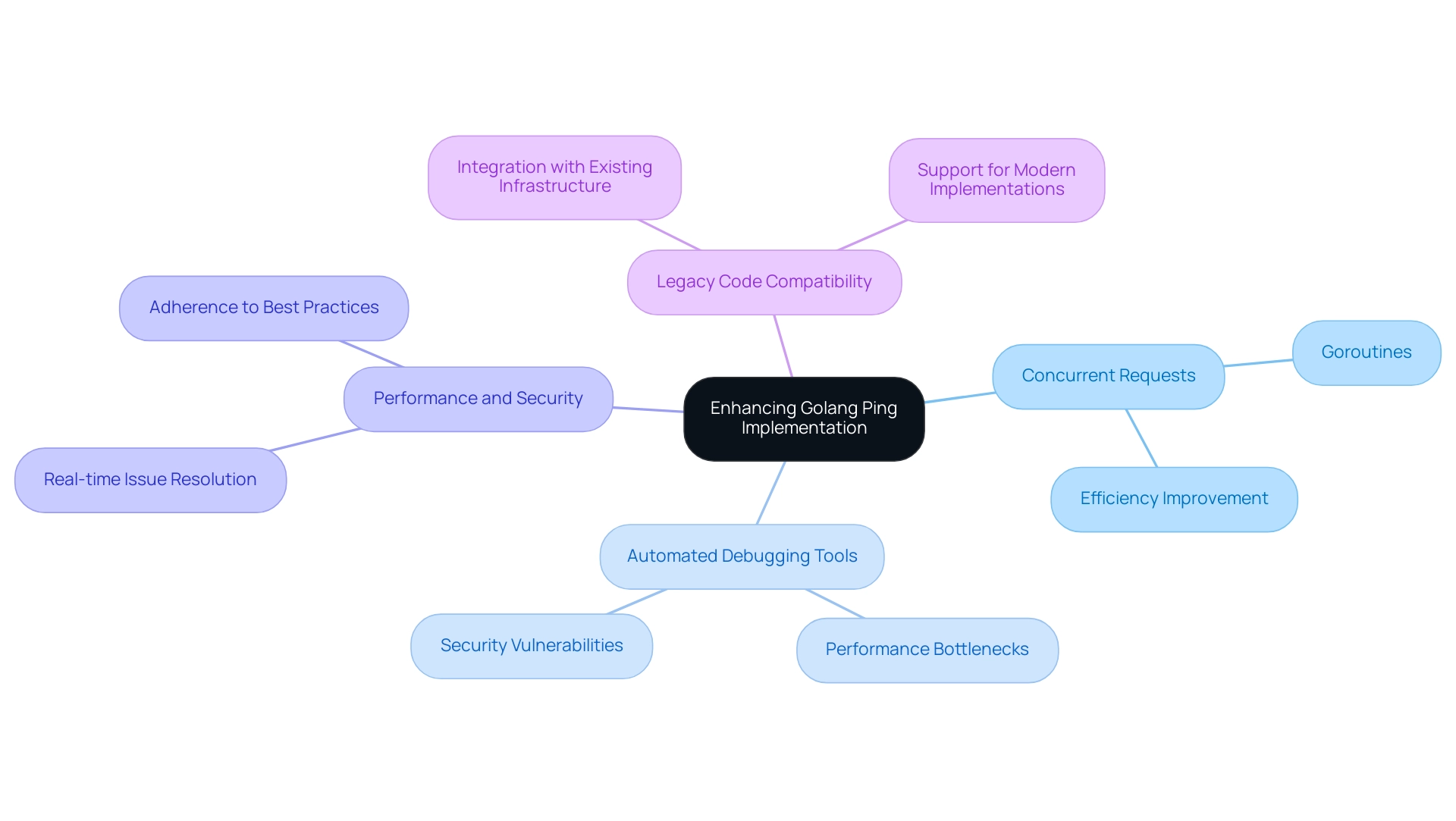Introduction
In the realm of network programming, the ability to assess connectivity is paramount, and the Ping function in Golang stands out as an essential tool for developers. By sending ICMP Echo Request messages and measuring the response time, this function empowers programmers to diagnose connectivity issues and optimize communication pathways within their applications.
As organizations increasingly rely on robust network monitoring tools, understanding how to effectively implement the Ping function becomes critical. This article delves into the intricacies of the Ping function, guiding readers through:
- Setup
- Implementation
- Troubleshooting
- Advanced techniques to enhance performance
With practical insights and real-world applications, developers will discover how to harness the power of Golang to ensure seamless and efficient network operations.
Understanding the Ping Function in Golang
The golang ping feature functions as an essential network tool intended to evaluate the accessibility of devices within an Internet Protocol (IP) network. By dispatching ICMP (Internet Control Message Protocol) Echo Request messages to the target host and awaiting Echo Reply messages, it facilitates the measurement of round-trip times for data packets sent from one host to another. Grasping this concept is crucial for developers engaged in networked applications, as it empowers them to effectively diagnose connectivity issues and ensure robust communication pathways.
The basic syntax for implementing the echo function involves utilizing the net package to establish connections and manage responses efficiently. Significantly, recent statistics suggest that nearly 10% of IT professionals intend to invest in monitoring tools over the next year. This trend underscores the growing reliance on utilities like golang ping in software development, highlighting its significance in maintaining optimal performance.
As one IT expert remarked, 'Investing in connectivity monitoring tools is essential for staying ahead of connectivity issues and ensuring seamless operations.' Furthermore, the ICMP protocol is essential not only for diagnostics but also for real-time monitoring, ensuring optimal performance and reliability. A practical use of this can be observed in the case study of Google Cloud Platform's Service Accounts & APIs, which describes the procedure of establishing a project that employs golang ping for effective data transfer and diagnostics, highlighting its real-world significance in ensuring secure and efficient network communications.

Setting Up Your Golang Environment for Ping Implementation
To effectively implement the echo function in Golang ping, begin by ensuring that Golang is properly installed on your machine. The official Golang website offers a straightforward download process. Following installation, create a dedicated directory for your project to maintain organization.
Initialize your module for golang ping by executing the command go mod init ping test, which sets up a new module tailored for your Ping application. It is essential to import the necessary packages to facilitate operations; specifically, include the net and time packages in your code. These packages enable you to manage connections and accurately measure response times.
Additionally, understanding statistical applications in Golang can be beneficial, as highlighted by the Mann-Whitney U-test, a non-parametric statistical test that can be implemented in your projects. As J. H. Klotz noted, 'The Wilcoxon, Ties, and the Computer,' emphasizes the importance of addressing ties in your statistical analysis. Once your code is set up, confirm that your Go environment is correctly configured by running go version in your terminal.
This step will help identify any discrepancies that might affect your project's performance, ensuring a seamless development experience. By integrating statistical methods like the Mann-Whitney U-test into your Golang projects, you can enhance the analytical capabilities of your applications.
Step-by-Step Guide to Writing the Ping Function in Golang
To implement a golang ping operation, begin by creating a new file, such as ping.go. Import the necessary packages to facilitate network operations and time measurement:
package main
import (
"fmt"
"net"
"time"
)
Next, define the Ping function, which will measure the response time for a given host:
func Ping(host string) (time.Duration, error) {
start := time.Now()
_, err := net.LookupHost(host)
if err != nil {
return 0, err
}
return time.Since(start), nil
}
This function accepts a host as a string and returns the round-trip time alongside any errors encountered during the lookup process. To utilize this function, invoke it within your main function and output the results:
func main() {
time, err := Ping("google.com")
if err != nil {
fmt.Println("Error:", err)
}
fmt.Printf("Ping time: %v\n", time)
}
This straightforward implementation effectively measures the response time to the specified host. As noted by Gowtham MS, the previous library go-ping is no longer maintained as of January 22, 2023. Therefore, leveraging the actively maintained fork, pro-Bing, will ensure that your code remains functional and efficient in the evolving Go landscape.
Notably, the go-ping library has had a total of 11 releases, which highlights its development history and reliability prior to its deprecation. Additionally, verifying if binding to an IP address is possible can enhance the functionality of your network diagnostic tool, especially for advanced users. This approach not only improves your application's reliability but also conforms to best practices in utility development.
Furthermore, the case study titled "Maintaining Libraries" emphasizes the importance of transitioning to actively maintained libraries like probing to avoid potential issues associated with outdated libraries.

Troubleshooting Common Issues in Golang Ping Implementation
When implementing the golang ping function, various common issues can hinder performance, such as connectivity problems, incorrect hostnames, and firewall restrictions. For instance, if you encounter an error related to the hostname, double-check that the server is reachable and that the spelling is accurate. In instances of connectivity issues, verify your internet connection and attempt to perform a golang ping on various hosts to pinpoint the source of the problem.
Firewalls can significantly impact ICMP traffic; if your setup blocks ICMP packets, adjusting your firewall settings to permit these packets is crucial. Incorporating error handling into your code can enhance troubleshooting—wrap error messages in more descriptive contexts to gain clearer insights into the nature of the issue. Such practices not only streamline the debugging process but also contribute to a more robust and efficient Golang application.
Moreover, using Kodezi's AI-powered tools can facilitate automatic bug analysis and code correction, allowing developers to focus on solutions rather than getting bogged down by issues. Kodezi is designed to act as an autocorrect for code rather than merely autocomplete, setting it apart from tools like Copilot. Kodezi CLI, for instance, acts as a Swiss-Army knife for programmers, enabling teams to auto-heal codebases instantly, thereby increasing productivity significantly.
Specific use cases, such as automatic bug fixing and code optimization, demonstrate how Kodezi can be applied effectively in real-world scenarios. As noted by Ryan Bradshaw, the top benefits of online networking include increased productivity (55%) and time-saving (92%), which can be especially relevant when seeking community support for troubleshooting in Golang. Additionally, the job market for cybersecurity professionals highlights a significant demand for skilled workers, with a projected need for 359,000 workers, emphasizing the importance of developing strong skills in Golang to address network issues effectively.
Interestingly, 16% of participants in a recent survey indicated that online networking results in less peer pressure, further underscoring the value of collaborative troubleshooting in a supportive community. For those interested in Kodezi, it offers both free and paid plans, making it accessible for programmers at various levels.
Enhancing Your Golang Ping Implementation with Advanced Techniques
To significantly enhance your implementation in Golang, integrating features such as concurrent requests is essential. This approach enables the simultaneous golang ping of multiple devices, which drastically enhances efficiency and responsiveness. Utilizing Goroutines is a powerful method to achieve this, as illustrated in the following function:
func ConcurrentPing(hosts []string) {
var wg sync.WaitGroup
for _, host := range hosts {
wg.Add(1)
go func(h string) {
defer wg.Done()
time, err := Ping(h)
if err != nil {
fmt.Println(
"Error pinging ", h, ": ", err)
} else {
fmt.Println("Ping to ", h, " took ", time)
}
}(host)
}
wg.Wait()
}
Incorporating concurrent pings not only enhances performance but also aligns with insights from automated code debugging, which allows for rapid issue resolution and optimization. Automated debugging tools can specifically enhance the concurrent golang ping implementation by identifying potential performance bottlenecks and security vulnerabilities in real-time, ensuring that the golang ping code adheres to the latest security best practices and coding standards. As noted by Matt, "Concurrency could be useful when you have operations that could run independently of each other but would otherwise run sequentially."
Furthermore, leveraging automated debugging tools can help identify performance bottlenecks and security issues, ensuring your codebase adheres to best practices and standards in seconds. The case study titled "Concurrent Programming Benefits" demonstrates that concurrent programming enhances software responsiveness and can increase speedup on multiple processors. By utilizing concurrent programming, developers can improve throughput and responsiveness, while considering Amdahl's and Gustafson's laws provides insights into the limits and potential of scalability.
Additionally, it's crucial to note the importance of compatibility with legacy code when choosing Golang for new systems, ensuring that existing infrastructure can effectively integrate with modern implementations.

Conclusion
The Ping function in Golang is an invaluable asset for developers aiming to maintain robust network operations. By understanding its implementation—from setup to troubleshooting—programmers can effectively diagnose connectivity issues and enhance application performance. The insights provided throughout the article illustrate not only the basic usage of the Ping function but also the advanced techniques that can optimize its functionality.
Emphasizing the importance of concurrent pings highlights how leveraging Goroutines can significantly improve efficiency, allowing developers to manage multiple network requests simultaneously. This approach not only streamlines operations but also aligns with best practices in network programming, ensuring applications remain responsive and reliable.
Ultimately, mastering the Ping function in Golang equips developers with the tools necessary for proficient network management. As reliance on network monitoring tools continues to grow, the ability to effectively implement and troubleshoot the Ping function will remain a vital skill in the developer toolkit. By embracing these techniques, programmers can ensure that their applications communicate seamlessly and perform optimally in an increasingly interconnected digital landscape.
Frequently Asked Questions
What is the purpose of the Golang ping feature?
The Golang ping feature is a network tool designed to evaluate the accessibility of devices within an IP network by sending ICMP Echo Request messages and measuring the round-trip times of data packets.
How does the Golang ping feature work?
It works by dispatching ICMP Echo Request messages to a target host and waiting for Echo Reply messages, which allows for measuring the round-trip time for data packets sent between hosts.
Why is understanding the Golang ping feature important for developers?
Understanding this feature is crucial for developers working on networked applications, as it helps diagnose connectivity issues and ensures robust communication pathways.
What is the basic syntax for implementing the echo function in Golang?
The basic syntax involves utilizing the net package to establish connections and manage responses efficiently.
What recent trend is noted among IT professionals regarding monitoring tools?
Nearly 10% of IT professionals plan to invest in monitoring tools over the next year, highlighting the growing reliance on utilities like Golang ping in software development.
How does the ICMP protocol contribute to network diagnostics?
The ICMP protocol is essential for diagnostics and real-time monitoring, ensuring optimal performance and reliability in network communications.
Can you provide an example of the practical use of Golang ping?
A case study on Google Cloud Platform's Service Accounts & APIs demonstrates the use of Golang ping for effective data transfer and diagnostics, showcasing its importance in secure and efficient network communications.
What are the initial steps to implement the echo function in Golang ping?
First, ensure Golang is installed, create a dedicated project directory, and initialize your module with the command go mod init ping test.
Which packages should be imported for Golang ping implementation?
You should import the net and time packages to manage connections and accurately measure response times.
How can statistical applications be integrated into Golang projects?
You can implement statistical methods like the Mann-Whitney U-test to enhance the analytical capabilities of your Golang applications.
What should be done to confirm the Go environment is correctly configured?
Run the command go version in your terminal to check for any discrepancies that might affect your project's performance.




